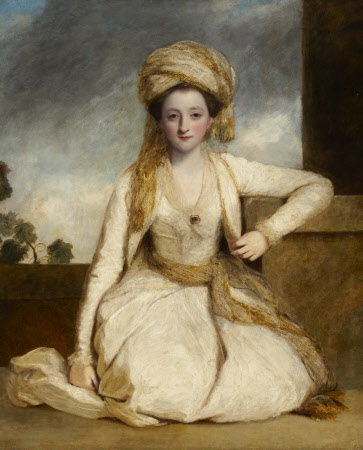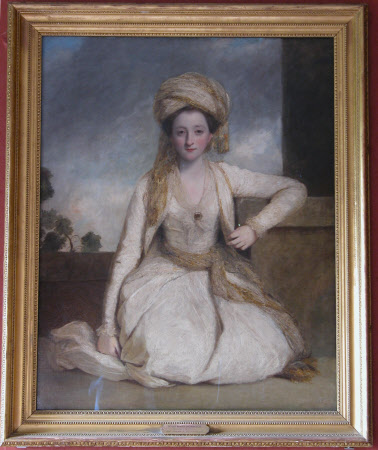Mary Horneck, "The Jessamy Bride" later Mrs Francis Edward Gwyn (?1752-1840)
Sir Joshua Reynolds PRA (Plympton 1723 - London 1792)
Category
Art / Oil paintings
Date
circa 1770 - 1775 (exh at RA)
Materials
Oil on canvas
Measurements
1270 x 1003 mm (50 x 39 ½ in)
Order this imageCollection
Cliveden Estate, Buckinghamshire
NT 766137
Summary
Oil painting on canvas, Mary Horneck, "The Jessamy Bride" later Mrs Francis Edward Gwyn (?1752-1840) by Sir Joshua Reynolds PRA (Plympton 1723 - London 1792), circa 1770/75. Full-length portrait of a young woman, kneeling on the floor at the base of a column on the right, wearing eastern dress of white silk turban, baggy dress in matching fabric with fitted bodice, under a long sleeved bolero jacket, a gold lame sash around waist
Full description
The sitter was the youngest daughter of Captain Kane Horneck of the Royal Engineers, and Hannah, his Devon-born wife, known as ‘The Plymouth Beauty’; in 1779 she married General Francis Gwyn, equerry to George III; Lady of the Bedchamber to Queen Charlotte. The Hornecks were a Devon family, descended from the Palatine divine, Anthony Horneck (1641–1697), to whom Goldsmith was probably introduced by their fellow-Devonian, Reynolds (whose portrait of the author is at Knole). Her elder sister, Catherine, was married in 1771 to the caricaturist Henry William Bunbury; she was called “Little Comedy” by Goldsmith and their eldest son was the “Master Bunbury” painted by Reynolds in 1781, whilst their second son, afterwards Sir Henry Edward Bunbury, 7th Bt, was his godson. Mary’s brother Charles, who was in the Guards, was known as the ‘Captain in Lace’. Goldsmith, who may have nurtured a slight tendre for Mary, ever since being introduced to her and her sister when she was fourteen, was friendly with both young women and their widowed mother, and in 1770 made a trip to Paris with them. His sobriquet of “the Jessamy [Jasmine] Bride” for Mary is of uncertain derivation or meaning. The secondary meaning of the word ‘jessamy’ appears to derive from those who were scented with jasmine, or wore a sprig of it: i.e. fops – but this is a male appellation. Could it be a coincidence that the sole illustration of the use of the word ‘jessamine’ given by Goldsmith’s friend Johnson in his Dictionary is, in a quotation from Spenser: “Her goodly bosom, like a strawberry bed; Her neck, like to a bunch of cullambines; Her breast like lilies, ere their leaves be shed; Her nipples, like young, blossom’d jessamines”. – at least, in his unconscious?! He uses it of her in his ‘Verses in reply to an invitation to dinner at Sir George Baker’s’ of c.1769, in a passage listing all the family: “So tell Horneck and Nesbitt And Baker and his bit, And Kauffman beside, And the Jessamy bride, With the rest of the crew, The Reynoldses two, Little Comedy’s face, And the Captain in lace ............................ Tell each other to rue Your Devonshire crew, For sending so late To one of my state.” By 1773, his affection for her was sufficiently notorious for his old enemy, Kenrick, to write an insulting letter to the London Packet (24 March 1773), signed “Tom Tickle”, abusing him as an author, and ridiculing his passion for “the lovely HXK”. Goldsmith, incensed, went round to his publisher’s, Evans’s, and struck the latter with his cane, from which a fight ensued. Goldsmith only avoided legal action, by agreeing to pay £50 to a Welsh charity, but relieved his feelings by writing a letter to the papers about the “licentiousness” of the press. A year later, Goldsmith was dead, but: “Before the body [Goldsmith’s] was buried, the Jessamy Bride and her sister turned from their family sorrows and scandals to pay a last tribute of affection to the poet. She had his coffin reopened and a lock cut from his head, which Mrs Gwyn kept till she died, nearly seventy years after.” (Tom Taylor, vol.ii, p.71). Aileen Ribeiro, in The Dress worn at Masquerades in England 1730–1790, New York, 1984, p.246, identifies the costume worn here as masquerade dress – but is it? Is it not rather a costume piece, in Indian dress? And could the motive for this have been some allusion to the sitter’s nickname of ‘The Jessamy Bride’?
Provenance
“Sir Joshua’s bequest: ‘To Mrs Gwyn; her own portrait, with a turban’” (Leslie & Taylor, Life of Reynolds, vol.ii, p.636); evidently given or left to her sister’s husband’s family; sold by Sir Henry Bunbury, Bt to William Waldorf Astor; by descent to William, 3rd Viscount Astor, by whom given to his brother David; presented to the National Trust for Cliveden by David Astor, CH, July 1994.
Makers and roles
Sir Joshua Reynolds PRA (Plympton 1723 - London 1792), artist

